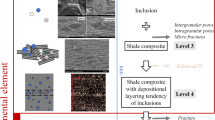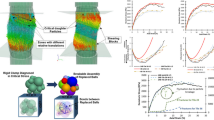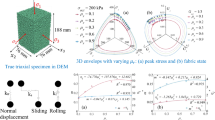Abstract
The discrete element method (DEM) can elucidate the macroscopic property changes caused by the breakage of granular materials from a microscopic perspective. In this paper, the fragment replacement method (FRM) volume expansion method is used to establish the DEM model for triaxial tests. Through numerical simulations of breakage and non-breakage of specimens with different gradation groups of characteristic particle sizes, the influencing factors of breakage and their microscopic responses are determined, and the critical states of crushed specimens are investigated. The results show that the shearing dilatancy characteristics of each specimen are governed by the stress level, and the dilatancy decreases as the stress increases; the differences in the macroscopic mechanical properties of the specimens of different gradation groups originate from particle fragmentation degree and the different particle contact effects; the characteristic state stresses of the specimens with different characteristic particle sizes are linear in the p-q plane, where q is the critical shear stress and p is the mean principal stress; as the content of fine particles decreases, the amount of breakage increases, and the line of the critical state void ratio shifts down and deflects more; at low confining pressure, particle breakage mainly occurs at the early stage of shear, while at high confining pressure, particle breakage accompanies the whole shear process.





















Similar content being viewed by others
Data availability
Some or all data, models, or codes that support the findings of this study are available from the corresponding author upon reasonable request and have no more supplementary information needs to be uploaded.
References
Airey DW, Fahey M (1991) Cyclic response of calcareous soil from the North-West Shelf of Australia. Géotechnique 41(1):101–121. https://doi.org/10.1680/geot.1991.41.1.101
Aqil U, Tatsuoka F, Uchimura T et al (2005) Strength and deformation characteristics of recycled concrete aggregate as a backfill material. Soils Found 45(5):53–72. https://doi.org/10.3208/sandf.45.5_53
Aström J, Herrmann H (1998) Fragmentation of grains in a two-dimensional packing. Eur Phys J B 5:551–554. https://doi.org/10.1007/s10051005047
Ben-Nun O, Einav I (2010) The role of self-organization during confined comminution of granular materials. Philos Trans R Soc A Math Phys Eng Sci 368(1910):231–247. https://doi.org/10.1098/rsta.2009.0205
Bi JF, Luo XQ, Shen H et al (2018) Fractal dimensions of granular materials based on grading curves. J Mater Civ Eng 30(6):04018083. https://doi.org/10.1061/(ASCE)MT.1943-5533.0002255
Borkovec M, Paris DW, Peikert R (1994) The fractal dimension of the apollonian sphere packing. Fractals 4(2):521–526. https://doi.org/10.1142/S0218348X94000739
Chang CS, Deng YB (2020) Modeling for critical state line of granular soil with evolution of grain size distribution due to particle breakage. Geosci Front 11(2):473–486. https://doi.org/10.1016/j.gsf.2019.06.008
Ciantia MO, Arroyo M, Calvetti F et al (2015) An approach to enhance efficiency of DEM modelling of soils with crushable grains. Géotechnique 65(2):91–110. https://doi.org/10.1680/geot.13.P.218
Cil MB, Alshibli KA (2014) 3D evolution of sand fracture under 1D compression. Géotechnique 64(5):351–364. https://doi.org/10.1680/geot.13.P.119
Cil MB, Buscarnera G (2016) DEM assessment of scaling laws capturing the grain size dependence of yielding in granular soils. Granular Matter 18(36):1–15. https://doi.org/10.1007/s10035-016-0638-9
Cleary PW (2001) Recent advances in DEM modelling of tumbling mills. Miner Eng 14:1295–1319. https://doi.org/10.1016/S0892-6875(01)00145-5
Cleary PW, Sinnott MD (2015) Simulation of particle flows and breakage in crushers using DEM: Part I -Compression crushers. Miner Eng 74:178–197. https://doi.org/10.1016/j.mineng.2014.11.017
Coop MR, Georgoutsos G, Bodas FT, Sorensen KK (2004) Particle breakage during shearing of a carbonate sand. Géotechnique 54(3):157–163. https://doi.org/10.1680/geot.2004.54.3.157
Cundall PA, Strack DL (1979) A discrete numerical model for granular assemblies. Géotechnique 29(1):47–65. https://doi.org/10.1680/geot.1979.29.1.47
De Bono JP, McDowell GR (2013) On the micro mechanics of one-dimensional normal compression. Géotechnique 63(11):895–908. https://doi.org/10.1680/geot.12.P.041
De Bono JP, McDowell GR (2014) DEM of triaxial tests on crushable sand. Granular Matter 16(4):551–562. https://doi.org/10.1007/s10035-014-0500-x
Einav I (2007) Breakage mechanics—Part I: Theory. J Mech Phys Solids 55(6):1274–1297. https://doi.org/10.1016/j.jmps.2006.11.003
Fukumoto T (1992) Particle breakage characteristics of granular soils. Soils Found 32(1):26–40. https://doi.org/10.3208/sandf1972.32.26
Guo WL, Zhu JG (2017) Energy consumption of particle breakage and stress dilatancy in drained shear of rockfill materials. Géotechnique 7:304–308. https://doi.org/10.1680/jgele.17.00099
Habib S, Reza R (2013) Effective parameters for the particle breakage of calcareous sands: an experimental study. Eng Geol 159(9):98–105. https://doi.org/10.1016/j.enggeo.2013.03.005
Hagerty MM, Hite DR, Ullrich CR, Hagerty DJ (1993) One-dimensional high-pressure compression of granular Media. J Geotechn Eng 119(1):1–18. https://doi.org/10.1061/(ASCE)0733-9410(1993)119:1(1)
Hanley KJ, O’Sullivan C, Huang X (2015) Particle-scale mechanics of sand crushing in compression and shearing using DEM. Soils Found 55(5):1100–1112. https://doi.org/10.1016/j.sandf.2015.09.011
Hardin BO (1985) Breakage of soil particles. J Geotechn Eng 111(10):1177–1192. https://doi.org/10.1061/(ASCE)0733-9410(1985)111:10(1177)
Indraratna B, Lackenby J, Christie D (2005) Effect of confining pressure on the degradation of ballast under cyclic loading. Géotechnique 55(4):325–328. https://doi.org/10.1680/geot.2005.55.4.325
Jiao S, Xu CS, Xu JL et al (2023) Influence of volume loss for the fragment replacement method (FRM) in three dimensions. J Mater Sci 58:3231–3248. https://doi.org/10.1007/s10853-023-08260-6
Kondner RL (1963) Hyperbolic stress-strain response: cohesive soils. J Soil Mech Found Div 89(1):115–143. https://doi.org/10.1061/JSFEAQ.0000479
Lade PV, Yamamuro JA, Bopp PA (1996) Significance of particle breakage in granular materials. J Geotechn Eng 122(4):309–316. https://doi.org/10.1061/(ASCE)0733-9410(1996)122:4(309)
Lee KL, Farhoomand I (1967) Compressibility and breakage of granular soil in anisotropic triaxial compression. Can Geotech J 4(1):68–86. https://doi.org/10.1139/t67-012
Li G, Liu YJ, Dano C, Hicher PY (2015) Grading-dependent behavior of granular materials: from discrete to continuous modeling. J Eng Mech 141(6):04014172. https://doi.org/10.1061/(ASCE)EM.1943-7889.0000866
Li H, McDowell G, Lowndes I (2014) Discrete element modelling of a rock cone crusher. Powder Technol 263:151–158. https://doi.org/10.1016/j.powtec.2014.05.004
Li XS, Dafalias YF (2000) Dilatancy for cohesionless soils. Géotechnique 50(4):449–460. https://doi.org/10.1680/geot.2000.50.4.449
Li XS, Wang Y (1998) Linear representation of steady-state line for sand. J Geotech Geoenviron Eng 124(12):1215–1217. https://doi.org/10.1061/(ASCE)1090-0241(1998)124:12(1215)
Marketos G, Bolton MD (2009) Compaction bands simulated in discrete element models. J Struct Geol 31(5):479–490. https://doi.org/10.1016/j.jsg.2009.03.002
Marsal RJ (1967) Large-scale testing of rockfill materials. J Soil Mech Found Div 93(2):27–43. https://doi.org/10.1061/JSFEAQ.0000958
McDowell GR (2002) On the yielding and plastic compression of sand. Soils Found 42(1):139–145. https://doi.org/10.3208/sandf.42.139
Miao G, Airey D (2013) Breakage and ultimate states for a carbonate sand. Géotechnique 63(14):1221–1229. https://doi.org/10.1680/geot.12.P.111
Nakata FL, Hyde M, Hyodo H, Murata (1999) A probabilistic approach to sand particle breakage in the triaxial test. Géotechnique 49(5):567–583. https://doi.org/10.1680/geot.1999.49.5.567
Nakata Y, Hyodo M, Hyde AF et al (2001) Microscopic particle breakage of sand subjected to high pressure one-dimensional compression. Soils Found 41(1):69–82. https://doi.org/10.3208/sandf.41.69
Omar AH, Faisal A, Husam AQ, Taleb AR (2010) Effect of grain breakage and bedding plane inclination on Aqaba sand behavior. Bull Eng Geol Environ 69(1):41–49. https://doi.org/10.1007/s10064-009-0238-6
Roscoe KH, Schofiled AN, Thurairajah AH (1963) Yielding of clays in states watter than critical. Géotechnique 13:211–240. https://doi.org/10.1680/geot.1963.13.3.211
Roscoe KH, Schofiled AN, Wroch CP (1958) On the yielding of soils. Géotechnique 8(1):22–53. https://doi.org/10.1680/geot.1958.8.1.22
Russell AR, Wood DM (2009) Point load tests and strength measurements for brittle spheres. Int J Rock Mech Min Sci 46(2):272–280. https://doi.org/10.1016/j.ijrmms.2008.04.004
Salim W, Indraratna B (2004) A new elastoplastic constitutive model for coarse granular aggregates incorporating particle breakage. Can Geotech J 41(4):657–671. https://doi.org/10.1139/t04-025
Shi DD, Cao D, Deng YB et al (2021) DEM investigations of the effects of intermediate principal stress ratio and particle breakage on the critical state behaviors of granular soils. Powder Technol 379:547–559. https://doi.org/10.1016/j.powtec.2020.10.094
Shi DD, Zheng L, Xue JF, Sun J (2016) DEM modeling of particle breakage in silica sands under one-dimensional compression. Acta Mech Solida Sin 29(1):78–94. https://doi.org/10.1016/S0894-9166(16)60008-3
Sitharam TG, Nimbkar MS (2000) Micromechanical modelling of granular materials: effect of particle size and gradation. Geotech Geol Eng 18(2):91–117. https://doi.org/10.1023/A:1008982027109
Thornton C (2000) Numerical simulations of deviatoric shear deformation of granular media. Géotechnique 50(1):43–53. https://doi.org/10.1680/geot.2000.50.1.43
Thornton C, Ciomocos MT, Adams MJ (1999) Numerical simulations of agglomerate impact breakage. Powder Technol 105(1-3):74–82. https://doi.org/10.1016/S0032-5910(99)00120-5
Varadarajan A, Sharma KG, Venkatachalam K, Gupta AK (2003) Testing and modeling two rockfill materials. J Geotech Geoenviron Eng 129(3):206–218. https://doi.org/10.1061/(asce)1090-0241(2003)129:3(206)
Wang X, Jiao Y, Wang R et al (2011) Engineering characteristics of the calcareous sand in Nansha Islands, South China Sea. Eng Geol 120(1/4):40–47. https://doi.org/10.1016/j.enggeo.2011.03.011
Wood MD, Maeda K (2008) Changing grading of soil: effect on critical states. Acta Geotech 3:3–14. https://doi.org/10.1007/s11440-007-0041-0
**ao Y, Meng MQ, Daousdji A et al (2020) Effects of particle size on breakage and deformation behaviors of rockfill materials. Geosci Front 11(2):375–388. https://doi.org/10.1016/j.gsf.2018.10.010
Xu YF, Feng XB, Zhu HG et al (2015) Fractal model for rockfill shear strength based on particle fragmentation. Granular Matter 17(6):753–761. https://doi.org/10.1007/s10035-015-0591-z
Yan WM, Dong JJ (2011) Effect of particle grading on the response of an idealized granular assemblage. Int J Geomech 11(4):276–285. https://doi.org/10.1061/(asce)gm.1943-5622.0000085
Yang J, Luo XD (2018) The critical state friction angle of granular materials: does it depend on grading? Acta Geotech 13:535–547. https://doi.org/10.1007/s11440-017-0581-x
Yu FW (2017) Characteristics of particle breakage of sand in triaxial shear. Powder Technol 320:656–667. https://doi.org/10.1016/j.powtec.2017.08.001
Zhang L, Evans TM (2018) Boundary effects in discrete element method modelling of undrained cyclic triaxial and simple shear element tests. Granular Matter 20(60):1–23. https://doi.org/10.1007/s10035-018-0832-z
Zhou M, Song E (2016) A random virtual crack DEM model for creep behavior of rockfill based on the subcritical crack propagation theory. Acta Geotech 11:827–847. https://doi.org/10.1007/s11440-016-0446-8
Zhou W, Yang LF, Ma G, Xu K, Lai ZQ, Chang XL (2017) DEM modeling of shear bands in crushable and irregularly shaped granular materials. Granular Matter 19(2):25. https://doi.org/10.1007/s10035-017-0712-y
Acknowledgements
This study was supported by the National Outstanding Youth Science Fund Project of the National Natural Science Foundation of China (Grant No.51722801).
Author information
Authors and Affiliations
Corresponding author
Ethics declarations
Ethical approval
Ethical approval is not applicable.
Conflict of interest
The authors declare no competing interests.
Rights and permissions
Springer Nature or its licensor (e.g. a society or other partner) holds exclusive rights to this article under a publishing agreement with the author(s) or other rightsholder(s); author self-archiving of the accepted manuscript version of this article is solely governed by the terms of such publishing agreement and applicable law.
About this article
Cite this article
Jiao, S., Xu, C., Xu, S. et al. Research on breakage mechanical properties of fragile granular material considering the effect of gradations. Bull Eng Geol Environ 82, 432 (2023). https://doi.org/10.1007/s10064-023-03455-2
Received:
Accepted:
Published:
DOI: https://doi.org/10.1007/s10064-023-03455-2




